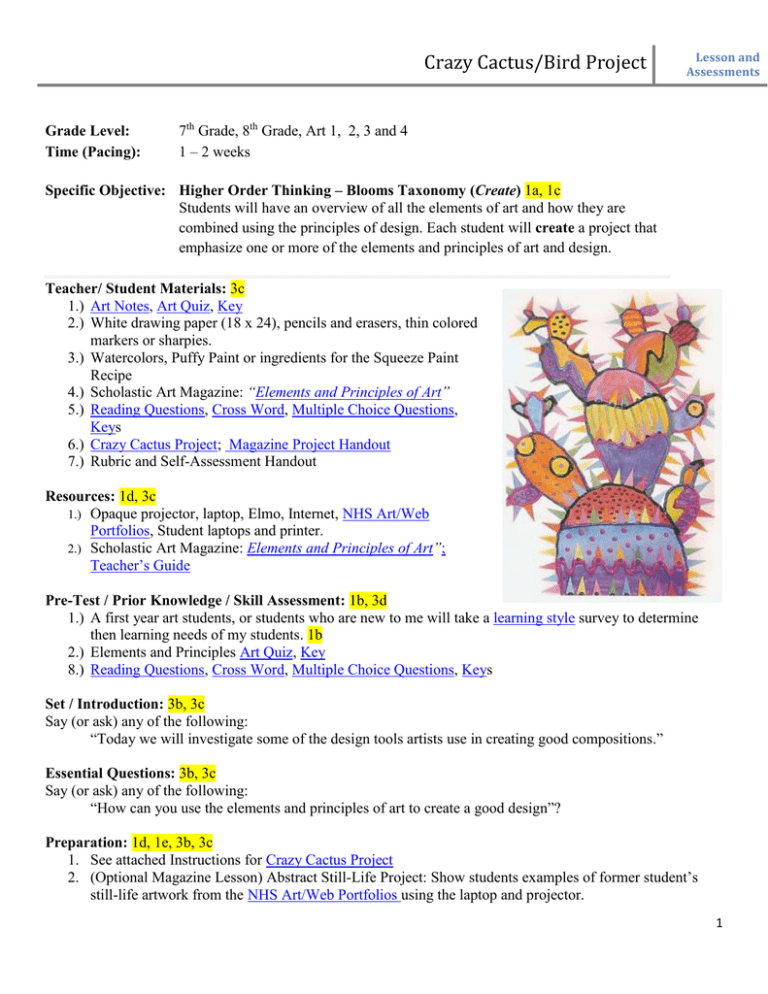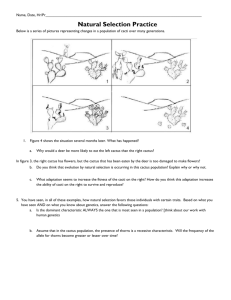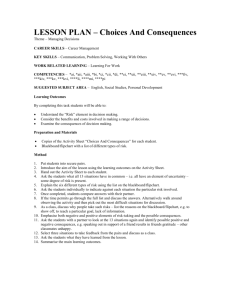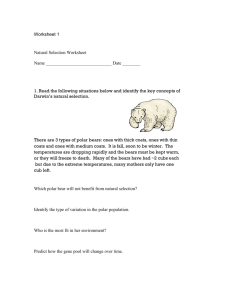Crazy Cactus/Bird Project
advertisement

Crazy Cactus/Bird Project Grade Level: Time (Pacing): Lesson and Assessments 7th Grade, 8th Grade, Art 1, 2, 3 and 4 1 – 2 weeks Specific Objective: Higher Order Thinking – Blooms Taxonomy (Create) 1a, 1c Students will have an overview of all the elements of art and how they are combined using the principles of design. Each student will create a project that emphasize one or more of the elements and principles of art and design. Teacher/ Student Materials: 3c 1.) Art Notes, Art Quiz, Key 2.) White drawing paper (18 x 24), pencils and erasers, thin colored markers or sharpies. 3.) Watercolors, Puffy Paint or ingredients for the Squeeze Paint Recipe 4.) Scholastic Art Magazine: “Elements and Principles of Art” 5.) Reading Questions, Cross Word, Multiple Choice Questions, Keys 6.) Crazy Cactus Project; Magazine Project Handout 7.) Rubric and Self-Assessment Handout Resources: 1d, 3c 1.) Opaque projector, laptop, Elmo, Internet, NHS Art/Web Portfolios, Student laptops and printer. 2.) Scholastic Art Magazine: Elements and Principles of Art”; Teacher’s Guide Pre-Test / Prior Knowledge / Skill Assessment: 1b, 3d 1.) A first year art students, or students who are new to me will take a learning style survey to determine then learning needs of my students. 1b 2.) Elements and Principles Art Quiz, Key 8.) Reading Questions, Cross Word, Multiple Choice Questions, Keys Set / Introduction: 3b, 3c Say (or ask) any of the following: “Today we will investigate some of the design tools artists use in creating good compositions.” Essential Questions: 3b, 3c Say (or ask) any of the following: “How can you use the elements and principles of art to create a good design”? Preparation: 1d, 1e, 3b, 3c 1. See attached Instructions for Crazy Cactus Project 2. (Optional Magazine Lesson) Abstract Still-Life Project: Show students examples of former student’s still-life artwork from the NHS Art/Web Portfolios using the laptop and projector. 1 Crazy Cactus/Bird Project Lesson and Assessments a. Gather still-life materials such as bones, plants, or fruit, or have students bring objects from home. b. (Optional) Create note cards, each listing three elements and one principle, to hand out to students. For example, balance is the principle and the elements are value, line, and shape. Students can choose one or more of the elements, depending upon their level of knowledge. Value is an important element, so it should be on all the cards. c. (For more advanced students) It helps if students have learned measuring techniques for drawing-including plumb and level, unit of measure, and finding the midpoint-prior to this assignment. They should have also spent time practicing gesture, blind contour, contour, and negative space drawings. (Drawing Insights: Size and Proportion) Modification / Option or Student Choice: 7th / 8th grade art; Art 1: Each student will use line, shape, color and texture elements and repetition/pattern, unity, focal point, variety, balance to create a “Crazy Cactus”. An informal teacher/student conference will be utilized to guide student with their drawing and design choice based on need and ability. 1b, 1c, 2a, 2b, 1f, 3a, 3e Art 3 and Art 4: Guided by an informal student/teacher conference, students will select artwork, ideas, and materials based on the needs of their portfolios and maturation. 1b, 1c, 1f, 2a, 2b, 3a, 3e Steps/Process: 1. Introduce the Crazy Cactus project (teacher may distribute the instructional handout to the students.) 2. Emphasize how to employ the elements and principles into creating this project. 3. Allow the students to create several thumbnail sketches of their ideas. 4. Demonstrate how to draw large on the 12 x 18” sheet of white tag board. 5. Set up materials stations and demonstrate and discuss the proper way to use and take care of the materials. 2c, 2e 6. Distribute Rubric and Self-Assessment handout and go over the project requirements. 1f, 3a, 3d 7. Students will fill out their rubrics and answer their self-assessment/reflection question and turn them in to the teacher. Common Core Literacy, 1f, 3a, 3b, 3d, 4b 8. Students will turn paper clip their nametags on their artwork and hang on the bulletin board for display and/or on their web portfolios. 1b, 1d, 1f, 2b, 3a, 3d, 4b, 4c, 4d, Daily Closure / Dismissal: Ask the students, “What did you had learned today?” Closure and Grading Criteria: (See attached Rubric) A self-reflection regarding the choice or imagery and the use of value to support the chosen theme is a standard part of the grading and is used as a starting point for a critique. 1f, 3d, 4b Arkansas State Frameworks: 1a, 1c 7th Grade: VA.5.7.1, VA.5.7.2, VA.5.7.3, VA.5.7.4, VA.5.7.5, VA.5.7.6, VA.5.7.7, VA.5.7.8, VA.5.7.9, VA.5.7.10, VA.5.7.11, VA.5.7.12, VA.5.7.13, VA.5.7.14, VA.5.7.15, VA.5.7.16, VA.6.7.1, VA.6.7.2, VA.6.7.3, VA.6.7.4, VA.7.7.1, VA.7.7.2, VA.7.7.6, VA.7.7.7 2 Crazy Cactus/Bird Project Lesson and Assessments 8th Grade: VA.5.8.1, VA.5.8.2, VA.5.8.3, VA.5.8.4, VA.5.8.6, VA.5.8.7, VA.5.8.8, VA.5.8.9, VA.5.8.10, VA.5.8.11, VA.5.8.12, VA.5.8.13, VA.6.8.1, VA.6.8.2, VA.6.8.3, VA.6.8.4, VA.6.8.13, VA.6.8.14, VA.7.8.1, VA.7.8.2, VA.7.8.6, VA.7.8.7 Art I: F.1.Al.1, F.1.Al.2, F.1.Al.3, F.1.Al.4, F.1.Al.5, F.1.Al.6, F.2.Al.1, F.2.Al.2, F.2.Al.3, F.2.Al.5, F.1.Al.6, F.1.Al.7, CP.4.Al.2, CP.4.Al.3, CP.4.Al.4, CP.4.Al.7, RR.5.Al.1, RR.5.Al.2, RR.5.Al.6, RR.5.Al.7 Art II: CP.1.Al1.2, CP.1.Al1.3, CP.1.Al1.4, CP.1.Al1.5, CP.1.Al1.6, CP.1.Al1.8, RR.2.A11.1, RR.2.A11.2, RR.2.A11.3, RR.2.A11.6, RR.2.A11.7, RR.2.A11.8 Art III: CP1.AIII.2; CP.1AIII.3, CP.1.AIII.4, CP.1.AIII.5, CP.1.AIII.8, RR.2.AIII.1, RR.2.AIII.2, RR.2.AIII.6, RR.2.AIII.7, RR.2.A11.8 Art IV: CP1.AIII.2 (Utilize sketchbook); CP.1AIV.3; (evidence of creative thinking and maturation), RR.2.AIV.1, RR.2.AIV.3 (Exhibit), RR.2.AIV.4 (Portfolio), RR.2.AIV.5 (Reflection) Common Core / Cross Curricular Connections: 1a Language Arts / English: Students reflect, evaluate and write on their self-assessments. Social Studies: Study of various artists across, time, place and cultures Technology Connections: Elmo/projector. Students work with laptops for self-assessments Math: Measuring skills and proportion skills are required to complete this project. Parental Involvement: 4c, 4d Projects, assignments and student work are posted online on school’s / art dept. website. a. Resources: See all resources and handouts on the following website http://panthers.k12.ar.us/High_School/Departments/Art/art_web_pages/Lessons/Syllabus/Syllab us.htm 3 Crazy Cactus/Bird Project Lesson and Assessments Rubric & SelfAssessment Student Name: ________________________________________ No Evidence -------------0 Needs Improvement---1-2-3 Average ------------------4-5-6 Good ----------------------6-8 Excellent-----------------9-10 1. Student idea gathering process - collection of images and / or symbols. (Evidence of Thoughtful Planning) Rate Yourself Teacher's Rating 2. Artwork contains all the required items and shows an understanding of the concepts or topics being depicted. 3. Student was productive, respectful and collaborates well with others for quality work. 4. Student demonstrates neatness, pride, positive attitude, follows directions. 5. Students showed evidence of creative thinking…Artwork is unique to individual. 6. Student meets deadline. 7. Tell me what you like most about your project AND why. (20 pts) 8. Tell me what you would do different about your project AND why. (20 pts) Total Points ______________/100____________ 4 Crazy Cactus/Bird Project Lesson and Assessments Abbreviated Frameworks: 7th Grade: 5.7.1 (line variety), 5.7.2 (2-d shapes & 3-d forms), 5.7.3 (color theory), 5.7.4 (texture variety), 5.7.5 (implied/simulated textures), 5.7.6 (spatial relationships), 5.7.7 (value ranges), 5.7.8 (complex patterns), 5.7.9 (movement/rhythm), 5.7.10 (proportion/scale), 5.7.11 (balance types), 5.7.12 (unity), 5.7.13 (variety), 5.7.14 (emphasis) 5.7.15 (relate art history to the artistic process), 5.7.16 (purpose for creating art), 5.7.17 (safety), 6.7.1(contour, gesture & sketches), 6.7.2 (full range of value), 6.7.3 (simulate surface qualities), 6.7.4 (apply spatial relationships), 6.7.5 (use of transfer methods – including grid), 6.7.6 (mix color/color theory), 6.7.7 (printmaking), 6.7.8 (3-d objects/elem & prin), 6.7.9 (using traditional & nontraditional methods, media & techniques), 6.7.10 (problem solving techniques), 6.7.11(content/communicate meaning), 6.7.12 (diverse cultures), 6.7.13(artwork from personal observations), 6.7.14 (cross the curriculum), 6.7.15 (collaboration), 7.7.1(historical connections between self/others), 7.7.2 (historical styles/periods), 7.7.3 (ways physical environment affects visual art), 7.7.4 (utilize art criticism), 7.7.5 (media, contemporary culture and art across the globe), 7.7.6 (exhibiting artwork), 7.7.7 (portfolios and self-assessments) 8th Grade: VA.5.8.1 (line), VA.5.8.2 (2-d shapes & 3-d forms), VA.5.8.3 (color theory), VA.5.8.4 (texture), VA.5.8.5 (linear & aerial perspective), VA.5.8.6 (values from direct observations), VA.5.8.7 (complex patterns which occurs in nature), VA.5.8.8 (movement and rhythm), VA.5.8.9 (proportion & scale), VA.5.8.10 (types of balance), VA.5.8.11 (unity), VA.5.8.12 (variety), VA.5.8.13 (emphasis), VA.5.8.14 (changes in media, styles & techniques over time) VA.5.8.15 (understand various purposes for creating art), VA. 5.8.16 (safety), VA.6.8.1 (contour, gesture & sketches), VA.6.8.2 (direct observation and gradation), VA.6.8.3 (simulate surface textures from direct observation), VA.6.8.4 (spatial relationships), VA.6.8.5 (use of transfer methods – including grid), VA.6.8.6 (mix color/color theory), VA.6.8.7 (printmaking), VA.6.8.8 (3-d objects/elem & prin), VA.6.8.9 (using traditional & nontraditional methods, media & techniques), VA.6.8.10 (problem solving techniques), VA. 6.8.11(content/communicate meaning), VA.6.8.12 (diverse cultures), VA.6.8.13 (artwork from personal observations), VA.6.8.14 (cross the curriculum), VA.6.8.15 (collaboration), VA.7.8.1 (historical connections between self/others), VA.7.8.2 (historical styles), VA.7.8.3 (ways physical environment affects visual art), VA.7.8.4 (utilize art criticism), VA.7.8.5 (media, contemporary culture and art across the globe), VA.7.8.6 (exhibiting artwork), VA.7.8.7 (portfolios and self-assessments) Art I: F.1.Al.1 (line), F.1.Al.2 (shape & form), F.1.Al.3 (color theory), F.1.Al.4 (textures), F.1.Al.5 (space), F.1.Al.6 (value), F.2.Al.1 (patterns), F.2.Al.2 (movement & rhythm), F.2.Al.3 (proportion), F.2.Al.4 (balance), F.2.Al.5 (unity & harmony), F.1.Al.6 (contrast), F.1.Al.7 (emphasis), F.3.Al.1 (changes over time, media, styles, and techniques), F.3.Al.2 (context/concepts), F.3.Al.3 (themes), CP.4.Al.1 (safety), CP.4.Al.2 (elem/prin/aesthetic concerns), CP.4.Al.3 (spatial relationships), CP.4.Al.4 (sketching), CP.4.Al.5 (sketchbook), CP.4.Al.6 (ideas/problem solving), CP.4.Al.7(direct observation), CP.4.Al.8 (color design), CP.4.Al.9 (printmaking), CP.4.Al.10 (collaboration), CP.4.Al.11(transfer methods), CP.4.Al.12 (additive/subtractive methods), CP.4.Al.13 (alternative & traditional techniques and media), RR.5.Al.1 (critique works), RR.5.Al.2 5 Crazy Cactus/Bird Project Lesson and Assessments (evaluate content & manner), RR.5.Al.3(reflect on impact of art), RR.5.Al.4 (reflect on ways art effects us), RR.5.Al.5 (respond/communications/media), RR.5.Al.6 (exhibit art), RR.5.Al.7 (student portfolios) Art II: CP.1.Al1.1 (safety), CP.1.Al1.2 (elem/prin/aesthetic concerns), CP.1.Al1.3 (spatial relationships), CP.1.Al1.4 (contour/gesture,sketching), CP.1.Al1.5 (sketchbook), CP.1.Al1.6 (ideas/problem solving), CP.1.Al1.7(visual cultures), CP.1.Al1.8 (direct observation), CP.1.Al1.9 (color theory), CP.1.A1l.10 (printmaking), CP.1.A1l.11(Collaboration), CP.1.Al1.12 (transfer method), CP.1.Al1.13 (additive/subtractive methods), CP.1.A11.14 (alternative techniques and media) CP.1.A11.15 (Content or theme) CP.1.A11.16 (inspired by…) RR.2.A11.1 (Critique), RR.2.A11.2 (Evaluate content/manner), RR.2.A11.3 (Impact on social, global), RR.2.A11.4 (environment), RR.2.A11.5 (symbols in communication media), RR.2.A11.6 (Exhibiting), RR.2.A11.7 (Portfolio), RR.2.A11.8 (cross curriculum) Art III: CP.AIII.1 (safety), CP1.AIII.2 (elem/prin/aesthetic concerns); CP.1AIII.3(spatial relationships), CP.1.AIII.4 (contour/gesture,sketching), CP.1.AIII.5 (sketchbook), CP.1.AIII.6 (artist’s statement ideas/ growth/problem solving), CP.1.AIII.7 (visual cultures), CP.1.AIII.8 (direct observation, chiaroscuro, abstract), CP.1.AIII.9 (color theory, mood, or atmospheric effects), CP.1.AIII.10 (printmaking), CP.1.AIII.11(Collaboration), CP.1.AIII.12 (transfer method, replica of images techniques), CP.1.AIII.13 (additive/subtractive 3-D methods), CP.1.AIII.14 (alternative techniques and media) CP.1.AIII.15 (Content or theme, artistic maturation) CP.1.AIII.16; (inspired by interdisciplinary connections) RR.2.AIII.1; (Critique artwork in history, culture and aesthetic theories), RR.2.AIII.2; (self and class evaluation content/manner), RR.2.AIII.3 (Impact on social, global), RR.2.AIII.4 (environment), RR.2.AIII.5 (symbols in communication media), RR.2.AIII.6 (Exhibiting), RR.2.AIII.7 (Portfolio), RR.2.A11.8 (cross curriculum) Art IV: CP.AIV.1 (safety), CP1.AIII.2 (Utilize sketchbook); CP.1AIV.3; (evidence of creative thinking and maturation), RR.2.AIV.1; (self and class evaluation content/manner), RR.2.AVI.2; (environment), RR.2.AIV.3 (Exhibit), RR.2.AIV.4 (Portfolio), RR.2.AIV.5 (Reflection) 6 Crazy Cactus/Bird Project Lesson and Assessments TESS Domain Documentation / Evidence DOMAIN 1: Planning and Preparation Location Completion 1a Demonstrating Knowledge of Content and Pedagogy L 5 1b Demonstrating Knowledge of Students L 3 1c Setting Instructional Outcomes L 4 1d 1e Demonstrating Knowledge of Resources Designing Coherent Instruction L L 3 1 1f Designing Student Assessments L 6 2a DOMAIN 2: Classroom Environment Creating an Environment of Respect and Rapport L 3 2b 2c Establishing a Culture for Learning Managing Classroom Procedures L L 2 1 2d Managing Student Behavior 2e Organizing Physical Space OB L 1 DOMAIN 3: Instruction 3a Communicating With Students L 5 3b 3c Using Questioning and Discussion Techniques Engaging Students in Learning L L 4 5 3d Using Assessment in Instruction L 5 3e Demonstrating Flexibility and Responsiveness DOMAIN 4: Professional Responsibilities L 2 4a Reflecting on Teaching 4b Maintaining Accurate Records L 3 4c Communicating with Families L 2 4d Participating in a Professional Community L 2 4e Growing and Developing Professionally PO 4f Showing Professionalism PO PO Location of Evidence Key: L=lesson plan; BF=binder file; W=website; SP=student portfolios; CL=communication log; R=rubric; SA=self-assessments; SC=student/teacher conference; PD=Professional Development; RC=records; PC=PreConference Questions; PO=Post Conference Questions; PS=Pre-Summative Evaluation Questions. 7 Crazy Cactus/Bird Project Lesson and Assessments Pre-Conference Questions: 1. (1a) How do the lesson concepts fit within the scope of the discipline? 2. (1b) How do you become familiar with the diversity (culture, learning styles, interest, special needs, etc.) of students in your class? How do you use knowledge of the diversity in your classroom in planning instruction for students to be successful in reaching the learning goal(s) of the lesson? 3. (1c) How does your lesson objective connect to prior lessons and future learning expectations? 4. (1c) What do you want students to know and be able to do as a result of this lesson? 5. (1d) What resources will you utilize to enhance this lesson? How will these instructional resources help you achieve the learning goals for the lesson? 6. (1e) Describe the structure of your lesson. How do you use the materials, methods, and activities to differentiate instruction for students to achieve the learning outcomes? 8 Crazy Cactus/Bird Project Lesson and Assessments How will you actively engage ALL students in the learning process? Describe and explain the various groupings of students throughout the lesson. 7. (1f) What methods of assessment (formative/summative) will you use to determine whether ALL students have mastered the learning goals? How will you use assessment data to plan for future instruction? 8. Is there anything else I need to know about the lesson? 9 Crazy Cactus/Bird Project Lesson and Assessments Post Conference Questions: 1. How would you describe today’s lesson? 2. (4a) What evidence is there that students did or did not learn the goals of the lesson? 3. (4a) What do samples of student work show about students levels of engagement and understanding during the lesson? 4. (4a) If you had the opportunity to work with the same students on this lesson again, what would you do the same? What would you do differently? 5. (4b) Please share your system for recording student assessment results. 6. (4b) Describe the system you have established to maintain your records of formative and summative assessments. 10 Crazy Cactus/Bird Project Lesson and Assessments 7. (4b/4c) How do you provide feedback on assessments for students and/or families? Share your record system to support that feedback? 8. (4b) What role do your students have in maintaining their own records of learning? How do your students determine their learning status from records and communicate this to their families? 9. (4c) How do you communicate with parents/guardians? How do they respond to your communications? 10. (4c) How do you address the concerns of parent/guardians during the school year? 11. (4c) Please describe the roles that families have in your classroom? What methods do you use to encourage family involvement? 12. (4c) How do your students participate in conversations with their families and with you, i.e., student led conferences, etc.? 11 Crazy Cactus/Bird Project Lesson and Assessments 13. (4d) How have you worked with colleagues on learning activities this year? Please describe some successes and areas for improvement for that collaboration. 14. (4d) What influence has your professional learning experiences had on your instruction this year? Describe some specific examples of change resulting from professional learning? 12 Crazy Cactus/Bird Project Lesson and Assessments Pre-Summative Evaluation Questions 1. Are there other artifacts reflecting your growth during the school year to submit prior to the final conference? 2. What examples of growth in identified components do I need to highlight from earlier in the year until now? 3. What changes, from professional learning attended, have enhanced your achievement in your growth areas this year? 13 Crazy Cactus/Bird Project Lesson and Assessments 14





